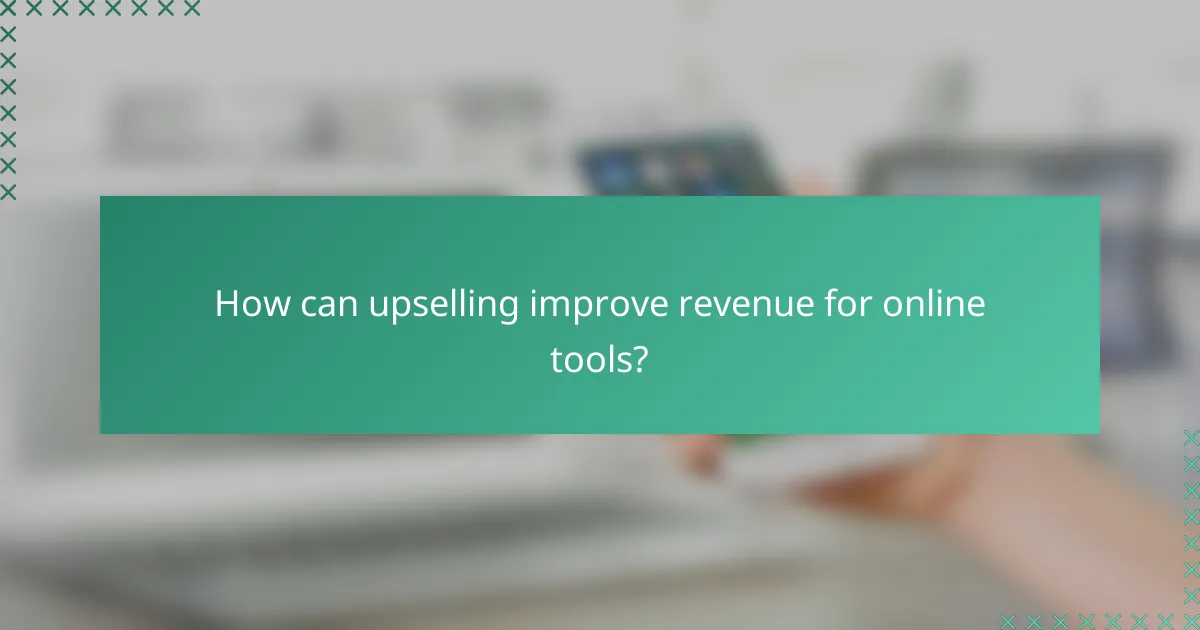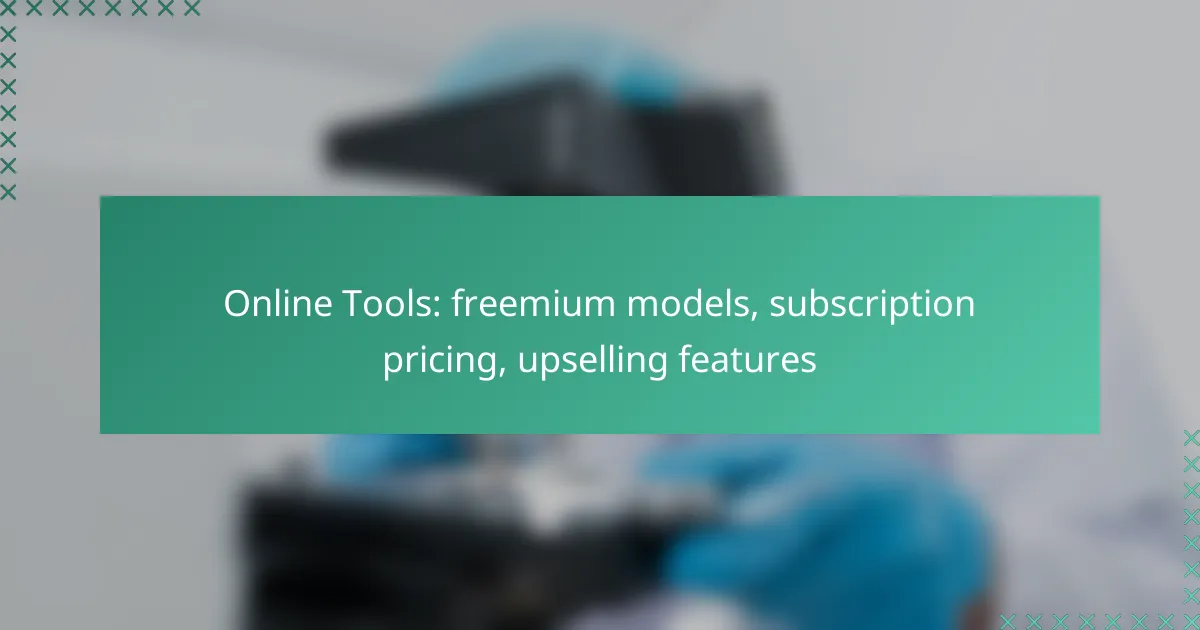Online tools often utilize freemium models, providing users with a basic version for free while offering advanced features at a cost. This strategy not only facilitates user acquisition but also enhances retention by allowing users to test the product before committing. Subscription pricing further supports this model by enabling users to pay a recurring fee for ongoing access, promoting revenue stability. Additionally, upselling features can significantly enhance user satisfaction by delivering added value, encouraging long-term loyalty to the service.

What are the best freemium models for online tools in Canada?
The best freemium models for online tools in Canada typically offer a basic version for free while charging for advanced features. This approach allows users to experience the product before committing to a subscription, making it an effective strategy for user acquisition and retention.
Dropbox’s storage model
Dropbox utilizes a freemium model that provides users with a limited amount of free cloud storage, typically around 2 GB. Users can upgrade to paid plans for additional storage and features, such as enhanced sharing options and increased file recovery capabilities.
One effective strategy for Dropbox is incentivizing referrals, where users can earn extra free storage by inviting friends to join. This not only boosts user engagement but also expands their customer base without significant marketing costs.
Canva’s design features
Canva’s freemium model offers users access to a wide range of design tools and templates for free, with premium features available through subscription plans. The free version includes basic editing tools, while paid subscriptions unlock advanced functionalities like brand kits and premium stock images.
Canva effectively upsells by showcasing the benefits of premium features directly within the platform. Users can see what they are missing, which encourages them to upgrade for a more comprehensive design experience. This model has proven successful in attracting both casual users and professionals seeking more robust design capabilities.

How does subscription pricing work for digital products?
Subscription pricing for digital products involves charging customers a recurring fee to access services or content. This model allows users to pay for what they use over time, rather than making a one-time purchase, which can enhance customer retention and revenue stability.
Monthly vs annual pricing
Monthly pricing allows users to pay a smaller amount each month, making it more accessible for those who prefer flexibility. However, this can lead to higher overall costs if users remain subscribed for an extended period.
Annual pricing typically offers a discount compared to monthly payments, incentivizing users to commit for a longer duration. For example, a service priced at $10 per month may cost $100 annually, saving users about 17% over the year.
Tiered pricing structures
Tiered pricing structures offer multiple subscription levels, each with different features and price points. This allows customers to choose a plan that best fits their needs and budget, ranging from basic access to premium features.
For instance, a software tool might have a basic plan at $5 per month, a standard plan at $15, and a premium plan at $30, with each tier unlocking additional functionalities. This approach can effectively cater to a wider audience and maximize revenue potential.

What upselling features enhance user experience?
Upselling features improve user experience by offering additional value through enhanced functionalities or services. These features can lead to greater satisfaction and retention, as users feel they are getting more from their subscriptions.
Feature unlocks
Feature unlocks allow users to access advanced tools or capabilities by upgrading their subscription. This can include additional storage, premium templates, or advanced analytics. For instance, a basic plan might offer limited project management tools, while a premium plan unlocks features like Gantt charts or team collaboration tools.
When implementing feature unlocks, consider the balance between free and paid offerings. Users should perceive enough value in the premium features to justify the upgrade. A common approach is to provide a trial period for premium features, allowing users to experience the benefits firsthand before committing financially.
Premium support options
Premium support options provide users with enhanced assistance, such as priority response times, dedicated account managers, or personalized onboarding sessions. This can significantly improve user satisfaction, especially for businesses that rely on the tool for critical operations. For example, a user on a premium plan may receive support within hours, while standard users might wait days.
Offering various tiers of support can cater to different user needs. Consider including options like live chat, phone support, or access to exclusive resources such as webinars and training materials. Ensure that the value of these premium support options is clearly communicated, as this can influence users’ decisions to upgrade their plans.

What are the key considerations for choosing a pricing model?
Choosing a pricing model involves evaluating user needs, market dynamics, and the features offered. Key considerations include understanding your target audience, assessing competitors, and determining how to balance free and paid offerings effectively.
User demographics
User demographics play a crucial role in selecting a pricing model. Understanding the age, income level, and preferences of your target audience can help tailor your offerings. For instance, younger users may prefer freemium models that allow them to try features before committing to a subscription.
Consider conducting surveys or analyzing user behavior to gather insights. This data can inform whether to adopt a low-cost subscription or a more premium pricing strategy, depending on what users are willing to pay.
Market competition
Analyzing market competition is essential when choosing a pricing model. Researching competitors can reveal common pricing strategies and gaps in the market. If most competitors offer similar features at a low price, you might need to differentiate your product or consider a unique pricing approach.
Keep an eye on industry trends and customer feedback to adapt your pricing strategy. For example, if competitors are increasingly adopting subscription models, you may want to explore similar options or enhance your upselling features to attract users.

How can upselling improve revenue for online tools?
Upselling can significantly enhance revenue for online tools by encouraging existing customers to purchase higher-tier plans or additional features. This strategy not only increases the average revenue per user but also fosters customer loyalty through enhanced service offerings.
Increased customer lifetime value
By implementing upselling strategies, online tools can boost customer lifetime value (CLV), which is the total revenue expected from a customer over their entire relationship. When users are presented with premium features or plans that align with their needs, they are more likely to invest in these options, resulting in higher overall spending.
For example, a project management tool might offer a basic plan for $10 per month and a premium plan for $30 per month. If a customer initially subscribes to the basic plan but later upgrades to the premium plan, their CLV increases significantly, benefiting the business in the long run.
Enhanced user engagement
Upselling can lead to enhanced user engagement by providing customers with features that improve their experience and productivity. When users see the value in upgraded features, they are more likely to utilize the tool more frequently, which can create a positive feedback loop of usage and satisfaction.
For instance, a software tool that offers advanced analytics as an upsell can help users make data-driven decisions, thereby increasing their reliance on the tool. This not only keeps users engaged but also encourages them to explore additional features, further increasing the likelihood of upselling opportunities.

What are the challenges of implementing freemium models?
Implementing freemium models presents several challenges, primarily around user conversion and feature management. Companies must balance offering enough value in the free tier to attract users while ensuring that the premium features are compelling enough to convert them into paying customers.
User conversion rates
User conversion rates are critical in determining the success of a freemium model. Typically, conversion rates can range from low single digits to around 10%, depending on the industry and the perceived value of premium features. Businesses must analyze user behavior to identify which features drive upgrades and refine their offerings accordingly.
To improve conversion rates, consider implementing targeted marketing strategies, such as personalized email campaigns or in-app prompts that highlight the benefits of upgrading. A/B testing different pricing strategies can also help identify the most effective approach for your audience.
Feature creep
Feature creep occurs when too many features are added to the product, often in an attempt to entice users to upgrade. This can lead to a cluttered user experience and dilute the core value proposition of the freemium model. It is essential to maintain a clear focus on the features that genuinely enhance user experience and drive conversions.
To manage feature creep, prioritize user feedback and data analytics to determine which features are most valued by users. Regularly review and streamline your offerings to ensure that both free and premium tiers remain attractive without overwhelming users with unnecessary options.

How do Canadian consumers respond to subscription pricing?
Canadian consumers generally appreciate subscription pricing for its affordability and convenience, often favoring models that offer flexibility and value. Many are willing to engage with freemium models, where they can try services before committing to a paid plan.
Preference for flexibility
Flexibility is a key factor for Canadian consumers when it comes to subscription pricing. Many prefer options that allow them to adjust their plans based on their needs, such as monthly billing cycles instead of annual commitments. This flexibility helps consumers feel more in control of their spending.
For example, services like streaming platforms often provide tiered subscription levels, enabling users to choose a plan that best fits their usage patterns. This adaptability can lead to higher customer satisfaction and retention rates.
Value perception
Value perception plays a significant role in how Canadian consumers respond to subscription pricing. They tend to evaluate whether the benefits of a subscription justify the cost, often comparing features and pricing against competitors. If a service offers unique features or superior quality, consumers may be more inclined to subscribe.
Additionally, clear communication about what is included in a subscription can enhance perceived value. For instance, offering exclusive content or additional features at no extra cost can make a subscription more appealing to potential customers.
